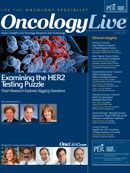Publication
Article
Oncology Live®
Optical Biomarkers Distinguish Risk Levels in Barrett's Esophagus
Author(s):
Optical biomarkers derived from nondysplastic metaplastic cells can detect the presence of high-grade dysplasia and adenocarcinoma from Barrett's esophagus.
Randall E. Brand, MD
Academic Director, GI Division UPMC Shadyside Director, GI Malignancy Early Detection, Diagnosis & Prevention Program, University of Pittsburgh Pittsburgh, PA
Optical biomarkers derived from nondysplastic metaplastic cells can detect the presence of high-grade dysplasia and adenocarcinoma from Barrett’s esophagus (BE), according to a study presented at the 2012 Gastrointestinal Cancers Symposium sponsored by the American Society of Clinical Oncology (ASCO). Optical biomarkers could be used to select patients who should go on to high-resolution endoscopy, and also who will require ablative therapy.
“Our biggest challenge is to identify high-risk patients who look normal on [conventional] endoscopy. The optical biomarkers can distinguish between BE without neoplastic changes from those with dysplasia,” stated Randall E. Brand, MD, University of Pittsburgh School of Medicine, Pennsylvania. “SLQPM (spatial-domain low-coherence quantitative phase microscopy)-derived biomarkers provide a promising approach for differentiation of dysplastic/ neoplastic BE from nondysplastic intraepithelial metaplasia. Future studies are warranted to expand our study population and develop additional new optical biomarkers to improve on current sensitivity and specificity and validate our findings.”
Because it is known that BE can progress from low-grade to high-grade dysplasia and invasive cancer, BE patients typically undergo endoscopic surveillance at 1- to 3- year intervals. Standard protocol includes four-quadrant random biopsies every 1-2 cm along the entire length of BE. Brand pointed out that random sampling is challenging due to the inability to differentiate patients with nondysplastic BE from those who have occult high-grade dysplasia, or who will progress to high-grade dysplasia or esophageal cancer. Therefore, optical biomarkers have the potential to fill an unmet need.
SL-QPM utilizes broadband light source, a microscope, and a tissue specimen. Cell changes are shown by light reflectance. The retrospective study reported at the symposium included archived specimens from 33 controls with BE and no cancer and 21 samples with high-grade dysplasia. The study also included six samples from patients with esophageal cancer.
Using optical signatures, three biomarkers were identified that can discriminate between cells with neoplasia and those with no neoplasia. A prediction model combining the three significant optical biomarkers had 89% sensitivity, 76% specificity, and 87% accuracy for distinguishing BE from high-grade dysplasia or esophageal cancer.
“If subsequent testing [of these optical biomarkers] proves successful, our approach could lead to simpler and more effective ways of monitoring patients with BE. Such a monitoring program would identify a subset of high-risk BE patients who require more intensive surveillance with high-resolution endoscopic imaging, and who could also be candidates for therapy to destroy the precancerous tissue. We need a way to select patients for high-resolution imaging—not all centers are equipped to do that,” Brand said.
Goblet cells in Barrett’s esophagus, stained blue on left side of image.
Brand outlined a potential approach for BE that incorporates SL-QPM as follows: Obtain two to three random tissue biopsies of BE, and evaluate them pathologically. Patients with evidence of dysplasia would receive treatment, while those with no clear evidence of dysplasia would undergo optical biomarker analysis. High-risk patients would be slated for high-resolution endoscopic imaging and ablative therapy, while low-risk patients would continue to have surveillance, but much less frequently.
The moderator of the press conference where these findings were discussed, Morton Kahlenberg, MD, said, “This is an exciting study suggesting that the biomarkers may be an additional test that can identify patients who harbor cells that will progress and a basis for modifying treatment.” Kahlenberg is medical director of Surgical Oncology Associates of South Texas in San Antonio.
Brand RE, Rizvi S, Davison JM, et al. Optical biomarkers from nondysplastic metaplastic cells can detect the presence of high-grade dysplasia and adenocarcinoma from Barrett’s esophagus. J Clin Oncol. 2012;30:(suppl 4; abstr 14).































%20(2)%201-Recovered-Recovered-Recovered-Recovered-Recovered-Recovered-Recovered-Recovered-Recovered-Recovered-Recovered-Recovered-Recovered-Recovered-Recovered-Recovered-Recovered.jpg?fit=crop&auto=format)
%20(2)%201-Recovered-Recovered-Recovered-Recovered-Recovered-Recovered-Recovered-Recovered-Recovered-Recovered-Recovered-Recovered-Recovered-Recovered-Recovered-Recovered-Recovered.jpg?fit=crop&auto=format)
